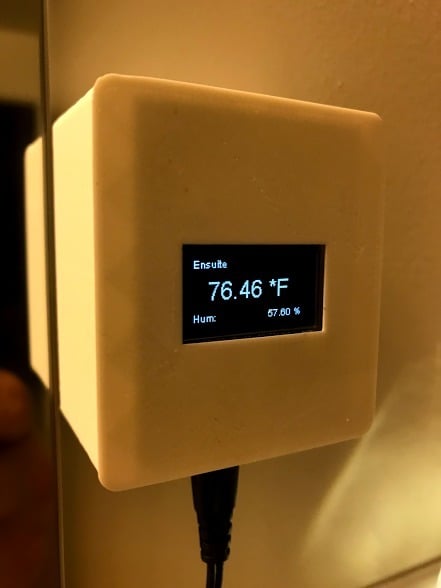
The Kube - ESP8266 NodeMCU DHT22 Local/Remote OLED Temperature/Humidity Sensor
thingiverse
***Overview video for this sensor: https://youtu.be/VefbT6RuT-4 ***\r\n***Build video (part 1 - hardware): https://youtu.be/fA91LcJRbhI ***\r\n***Build video (part 2 - software): https://youtu.be/uDsnqi1Vl4U ***\r\n***Build video (part 3 - openHAB): https://youtu.be/yHt19wZBnDo ***\r\n\r\n***SEE BELOW FOR BUILD INSTRUCTIONS***\r\n\r\nThis project is my homemade/DIY temperature/humidity sensor, built around the NodeMCU ESP8266 and a DHT22 sensor. It uses a custom-made breakout board for the NodeMCU/DHT that I designed in Eagle (available on Tindie: https://www.tindie.com/products/11677/). The breakout board makes it easy to connect devices like an OLED screen, motion sensors, or WS2812 RGB LED strings. The NodeMCU itself runs code I wrote or ESPEasy to collect temp/humidity/motion inputs and publish them via MQTT to my openHAB home automation system.\r\n\r\nThis enclosure was designed to make the whole setup look more pleasing to the eye, rather than having random PCBs out around the house. It's a much-needed upgrade from the original prototype.\r\n\r\nDesign features added since the original prototype (9/17/17):\r\n-Edges on the bottom of the enclosure hold the PCB in place.\r\n-Rounded edges give it a more aesthetic look.\r\n-Mounting posts for the OLED display can be melted down with a soldering iron to hold the display in place.\r\n-An EXT connector allows for external inputs/outputs (motion, pressure, luminosity sensors, servos, etc...).\r\n-Louvers match the DHT sensor's side/top openings for better airflow/sensing and aesthetics.\r\n-The second version of the box has diagonal louvers along both sides. Originally designed for airflow, they're now purely aesthetic due to calibration issues resolving reporting problems.\r\n-The breakout board supports both NodeMCU 0.9 and 1.0 ("v2"). Note that V3 will not fit in this enclosure!\r\n-Counter-sunk holes on the bottom cover hide screw heads and make the box flat on the wall.\r\n-A 3.3/5v selector jumper selects which voltage is sourced for the external sensor power rail. The board is 100% tested and works perfectly.\r\n\r\nThis design is ***COMPLETE***\r\n\r\n-----\r\n\r\n***Check out my YouTube channel https://www.youtube.com/c/BKHobby for how-to videos about 3D modeling, printing, and home automation.***\r\n\r\nCheck out my (mostly functional) 3D designs at (https://www.thingiverse.com/bkpsu/designs)! If you like them and want to support my projects, use one of the links below when you're planning to buy anything from these sites (it won't cost you anything extra!). Thank you in advance!\r\n\r\nBanggood: https://goo.gl/uXGg84\r\nAliExpress: https://goo.gl/KRNurW\r\nAmazon: https://goo.gl/nWhmjJ
With this file you will be able to print The Kube - ESP8266 NodeMCU DHT22 Local/Remote OLED Temperature/Humidity Sensor with your 3D printer. Click on the button and save the file on your computer to work, edit or customize your design. You can also find more 3D designs for printers on The Kube - ESP8266 NodeMCU DHT22 Local/Remote OLED Temperature/Humidity Sensor.
